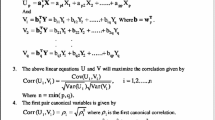Abstract
In this paper, we propose a new method for the blind source separation with assuming that the source signals are cyclostationarity. The proposed method exploits the characteristics of cyclostationary signals in the Fraction-of-Time probability framework in order to simultaneously separate all sources without restricting the distribution or the number of cycle frequencies of each source. Furthermore, a new identifiability condition is also provided to show which kind of cyclostationary source can be separated by the second-order cyclostationarity statistics. Numerical simulations are presented to demonstrate the effectiveness of the proposed approach.
Preview
Unable to display preview. Download preview PDF.
Similar content being viewed by others
References
Tong, L., Liu, R., Soon, V.C., Huang, Y.F.: Indeterminacy and identifiability of blind identification. IEEE Trans. Circuits Sys. 38(5), 499–509 (1991)
Belouchrani, A., Abed-Meraim, K., Cardoso, J.F., Moulines, E.: A blind source separation technique using second order statistics. IEEE Trans. Signal Process. 45(2), 434–444 (1997)
Cardoso, J.F.: Blind beam forming for non Gaussian signals. IEE proceedings 140(6), 362–370 (1993)
Gardner, W.A.: Statistical Spectral Analysis: A Nonprobabilistic Theory. Prentice Hall, Englewood Cliffs (1988)
Spooner, C.M.: Theory and application of higher order cyclostationarity, Dept. Elec. Comput. Eng., Univ. of CA (1992)
Gardner, W.A.: Cyclostationarity in Communications and Signal Processing. IEEE Press, Los Alamitos (1994)
Gardner, W.A., Napolitano, A., Paura, L.: Cyclostationarity: half a century of research. Signal Processing 86(4), 639–697 (2006)
Napolitano, A.: Cyclic higher-order statistics: input/output relations for discrete and continuous-time MIMO linear almost-periodically time-variant systems. Signal processing 42(2), 147–166 (1995)
Liang, Y.C., Leyman, A.R., Soong, B.H.: Blind source separation using second order cyclic statistics. In: Pro. SPWAC, Paris, France, pp. 57–60 (1997)
Ferreol, A., Chevalier, P.: On the behavior of current second and higher order blind sourceseparation methods for cyclostationary sources. IEEE Trans. Signal Process. 48(6), 1712–1725 (2000)
Abed-Meraim, K., Xiang, Y., Manton, J.H., Hua, Y.: Blind source separation using second-order cyclostationary statistics. IEEE Trans. Signal Process. 49(2), 694–701 (2001)
Jallon, P., Chevreuil, A.: Separation of instantaneous mixtures of cyclo-stationary sources. Signal Process. 87(11), 2718–2732 (2007)
Pham, D.T.: Blind separation of cyclostationary sources using joint block approximate diagonalization. In: Davies, M.E., James, C.J., Abdallah, S.A., Plumbley, M.D. (eds.) ICA 2007. LNCS, vol. 4666, pp. 244–251. Springer, Heidelberg (2007)
CheViet, N.A., El Badaoui, M., Belouchrani, A., Guillet, F.: Blind separation of cyclostationary sources using joint block approximate diagonalization. In: Proc. 5th IEEE SAM, Darmstadt, Germany, July 21-23, pp. 492–495 (2008)
Tong, L., Inouye, Y., Liu, R.W.: Waveform-preserving blind estimation of multiple idependent sources. IEEE Trans. Signal Process. 41(7), 2461–2470 (1993)
Tong, L., Inouye, Y., Liu, R.: A finite-step global convergence algorithm for the parameter estimation of multichannel MA processes. IEEE Trans. Signal Process. 40(10), 2547–2558 (1992)
Schell, S.V., Gardner, W.A.: Progress on signal selective direction finding. In: Proc. Fifth IEEE/ASSP Workshop Spectrum Estimation and Modelling, Rochester, NY, pp. 144–148 (1990)
Dandawaté, A.V., Giannakis, G.B.: Statistical tests for the presence of cyclostationarity. IEEE Trans. Signal Processing 42, 2355–2369 (1994)
Author information
Authors and Affiliations
Editor information
Editors and Affiliations
Rights and permissions
Copyright information
© 2009 Springer-Verlag Berlin Heidelberg
About this paper
Cite this paper
Cheviet, N.A., El Badaoui, M., Belouchrani, A., Guillet, F. (2009). Blind Separation of Cyclostationary Signals. In: Adali, T., Jutten, C., Romano, J.M.T., Barros, A.K. (eds) Independent Component Analysis and Signal Separation. ICA 2009. Lecture Notes in Computer Science, vol 5441. Springer, Berlin, Heidelberg. https://doi.org/10.1007/978-3-642-00599-2_4
Download citation
DOI: https://doi.org/10.1007/978-3-642-00599-2_4
Publisher Name: Springer, Berlin, Heidelberg
Print ISBN: 978-3-642-00598-5
Online ISBN: 978-3-642-00599-2
eBook Packages: Computer ScienceComputer Science (R0)




